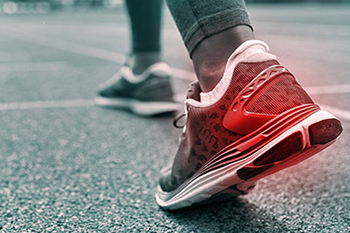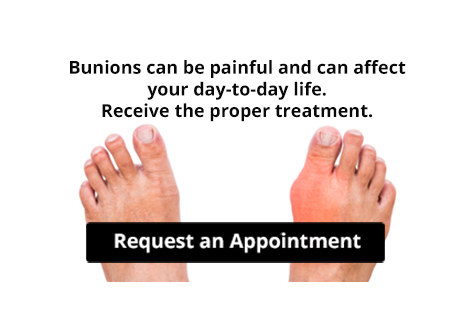
Blog (864)
Are Bunions Affecting Your Everyday Life?
The Feet Can Be Likened to a Work of Art

There are 26 bones in each foot, accompanied by several joints, tendons, muscles, and ligaments. The feet comprise 25% of all the bones in the body, and it is important to practice everyday foot care that can benefit the entire body. The feet can be likened to a machine, and the muscles and joints can represent pulleys and levers that can move side to side and up and down. This is instrumental in walking, running, and completing everyday activities, and many people have considered the feet to be a “work of art." As the aging process occurs, the feet may start to wear and tear, and uncomfortable foot conditions may develop. Dry skin can possibly be reduced when a good moisturizer is used on them daily. Additionally, the chances of getting athlete’s foot and toenail fungus may decrease when appropriate shoes are worn in public swimming pool and locker room areas. It is beneficial to wear shoes that fit correctly, and this may help to prevent hammertoe and bunions from developing. Additionally, the feet will feel good at the end of the day when they are soaked in warm water and scented oil. For more information about everyday foot care tips, it is suggested that you speak with a podiatrist who can provide you with answers to any questions you may have.
Everyday foot care is very important to prevent infection and other foot ailments. If you need your feet checked, contact one of our podiatrists from Westland Foot & Ankle Specialists, P.C.. Our doctors can provide the care you need to keep you pain-free and on your feet.
Everyday Foot Care
Often, people take care of their bodies, face and hair more so than they do for their feet. But the feet are a very important aspect of our bodies, and one that we should pay more attention to. Without our feet, we would not be able to perform most daily tasks.
It is best to check your feet regularly to make sure there are no new bruises or cuts that you may not have noticed before. For dry feet, moisturizer can easily be a remedy and can be applied as often as necessary to the affected areas. Wearing shoes that fit well can also help you maintain good foot health, as well as making it easier to walk and do daily activities without the stress or pain of ill-fitting shoes, high heels, or even flip flops. Wearing clean socks with closed shoes is important to ensure that sweat and bacteria do not accumulate within the shoe. Clean socks help to prevent Athlete’s foot, fungi problems, bad odors, and can absorb sweat.
If you have any questions please feel free to contact our office located in Westland, MI. . We offer the newest diagnostic and treatment technologies for all your foot and ankle needs.
Different Types of Flat Feet

Flat feet is a somewhat self-explanatory foot affliction that can affect a wide variety of individuals. This condition occurs when someone has no visible arch in their foot, or it may partially or completely disappear when the foot is on the ground. In other words, people with flat feet have no gap between the ground and the middle point of the soles of their feet. When standing, people with flat feet will be able to press their entire foot flush against the ground. While this condition can occur in children, adults may also be susceptible to flat feet. There are two main kinds of flat feet that you ought to be aware of. The first kind is known as flexible flat foot. This typically occurs in children when the arch of their feet disappears when standing, but it reappears when the child is sitting down. In some cases, children with flexible flat foot will also exhibit arches in their feet when walking on their tip toes. The second kind is known as rigid flat foot. This kind of flat foot is seen in both children and adults who never exhibit any kind of arch in their feet, whether they are walking normally, walking on their tip toes, or sitting down. If you believe you might have flat feet, consider contacting a podiatrist who can provide guidance and assistance.
Flatfoot is a condition many people suffer from. If you have flat feet, contact one of our podiatrists from Westland Foot & Ankle Specialists, P.C.. Our doctors will treat your foot and ankle needs.
What Are Flat Feet?
Flatfoot is a condition in which the arch of the foot is depressed and the sole of the foot is almost completely in contact with the ground. About 20-30% of the population generally has flat feet because their arches never formed during growth.
Conditions & Problems:
Having flat feet makes it difficult to run or walk because of the stress placed on the ankles.
Alignment – The general alignment of your legs can be disrupted, because the ankles move inward which can cause major discomfort.
Knees – If you have complications with your knees, flat feet can be a contributor to arthritis in that area.
Symptoms
- Pain around the heel or arch area
- Trouble standing on the tip toe
- Swelling around the inside of the ankle
- Flat look to one or both feet
- Having your shoes feel uneven when worn
Treatment
If you are experiencing pain and stress on the foot you may weaken the posterior tibial tendon, which runs around the inside of the ankle.
If you have any questions please feel free to contact our office located in Westland, MI. . We offer the newest diagnostic and treatment technologies for all your foot and ankle needs.
Removing Corns on the Feet

Corns are hard, callus-like growths that can develop on your feet. They usually develop in response to repeated pressure applied to a point on the foot, usually from ill-fitting or tight footwear. If you have corns on your feet, you should consult with a podiatrist to address the problem in the best possible way. In some cases, you might be able to remove the corn with a few at-home remedies. However, those with diabetes, circulatory disorders, and certain other conditions should never attempt to treat a corn by themselves. The most common way to remove corns involves soaking the feet in warm water for approximately ten minutes. This is done to soften the affected skin on the feet. After this step, you may be able to gently file down the outer layers of the corn by using a pumice stone or an emery board. However, it is important not to file excessively because you might end up injuring the deeper layers of the skin. There are also a variety of over-the-counter products that you might find useful in attempting to remove the corn on your feet. For example, you can use products such as lotions or scrubs that contain salicylic acid. This acid works to break down the corn. When in doubt, it is best to contact a trusted podiatrist who can help you determine the best way for the corn to be removed.
If you have any concerns regarding your feet and ankles, contact one of our podiatrists of Westland Foot & Ankle Specialists, P.C.. Our doctors will treat your foot and ankle needs.
Corns: What Are They? and How Do You Get Rid of Them?
Corns can be described as areas of the skin that have thickened to the point of becoming painful or irritating. They are often layers and layers of the skin that have become dry and rough, and are normally smaller than calluses.
Ways to Prevent Corns
There are many ways to get rid of painful corns such as wearing:
- Well-fitting socks
- Comfortable shoes that are not tight around your foot
- Shoes that offer support
Treating Corns
Treatment of corns involves removing the dead skin that has built up in the specific area of the foot. Consult with Our doctors to determine the best treatment option for your case of corns.
If you have any questions please feel free to contact our office located in Westland, MI. . We offer the newest diagnostic and treatment technologies for all your foot and ankle needs.
Are You Suffering From Ingrown Toenails?
How to Shop for a Properly Fitting Pair of Shoes

Maintaining good foot health is essential to ensuring that your entire body is healthy and intact. It is estimated that millions of people across the United States experience some foot pain or condition because of ill-fitting shoes. Therefore, knowing how shoes ought to fit your feet and what to look for when you go shoe shopping can positively impact the health and vitality of your feet. While each person’s shoe shopping experience is unique, there are several rules of thumb that might apply to everyone. First, you might be especially mindful of finding a shoe that mirrors the shape of your foot. Although it might seem obvious, many people overlook how important it is to select shoes that are not smaller or narrower than the natural shape of their own foot. Additionally, one must be mindful of the fact that shoe sizes are not uniform across brands or shoe types. Therefore, instead of relying exclusively on your numerical shoe size when shopping, you might consider using these numbers as guides, focusing more on the fit of the shoe than the size. Lastly, look for shoes that provide adequate space in the toe box of the shoe. In a good-fitting pair of shoes, your longest toe will not rest flush against the front of the shoe. Leave at most one half an inch between your longest toe and the front of the shoe. For more tips on how to shop for a good pair of shoes, consult a podiatrist.
Finding a properly-fitting shoe is important in reducing injuries and preventing foot problems. For more information about treatment, contact one of our podiatrists from Westland Foot & Ankle Specialists, P.C.. Our doctors will treat your foot and ankle needs.
Proper Shoe Fitting
A common concern when it comes to foot health, having properly fitted shoes can help prevent injuries to the foot. Out feet affect our posture and gait, which in turn affects the biomechanics and overall bodily structure. With 33 joints, 26 bones, and over 100 ligaments, the potential for serious injury is much greater than one realizes. Although the feet cease growth in adulthood, they still change shape as they mature. Here are some factors to consider when it comes to investing in proper fitting shoes:
- Be sure the shoes fit correctly right away
- Ensure the ball of your foot fits comfortably in the widest portion of the shoes
- Even though they may look fashionable, improper fitting shoes can either create adverse conditions or exacerbate existing ones you may already have
- Walk along a carpeted surface to ensure the shoes comfortably fit during normal activity
Keeping in mind how shoes fit the biomechanics of your body, properly-fitting shoes are vitally important. Fortunately, it is not difficult to acquire footwear that fits correctly. Be sure to wear shoes that support the overall structure of your body. Do your feet a favor and invest in several pairs of well-fitted shoes today.
If you have any questions please feel free to contact our office located in Westland, MI. . We offer the newest diagnostic and treatment technologies for all your foot and ankle needs.
Different Shoes for Various Styles of Running

There are several reasons why people choose to run. These include losing weight, training for a marathon, or jogging for pure enjoyment. There are different types of shoes for various styles of running, and it is beneficial to choose the type of shoe that fits comfortably, while enhancing the type of running that is desired. There are many factors that can determine what kind of shoes are purchased. These consist of weight, what type of surfaces are run on, and foot structure. Research has shown foot conditions may be avoided when properly fitting running shoes are worn. These include plantar fasciitis, ankle sprains, and general aches and pains in the foot and arch area. When the right shoes are worn, they are typically comfortable, and feel like they are part of the foot. Many people who enjoy running prefer to shop at a specialty store where they can get advice in matching their foot type to the appropriate shoe. There are different shoes that target a forefoot or heel striker, and it is important to know what type of running is done. If you would like additional information about how to purchase the correct running shoe, please confer with a podiatrist who can answer any questions you may have.
If you are a runner, wearing the right running shoe is essential. For more information, contact one of our podiatrists from Westland Foot & Ankle Specialists, P.C.. Our doctors can provide the care you need to keep you pain-free and on your feet.
Choosing the Right Running Shoe for Your Foot Type
To increase performance and avoid the risk of injury, it is important to choose the right running shoe based on your foot type. The general design of running shoes revolves around pronation, which is how the ankle rolls from outside to inside when the foot strikes the ground.
- Neutral runners are able to choose from a wide variety of shoes, including minimalist shoes or even going barefoot.
- Runners who overpronate, or experience an over-abundance of ankle rolling, should choose shoes that provide extra motion control and stability.
- Runners who underpronate, or supinate, have feet that have high arches and lack flexibility, preventing shock absorption. They require shoes with more flexibility and cushion.
If you have any questions please feel free to contact our office located in Westland, MI. . We offer the newest diagnostic and treatment technologies for all your foot and ankle needs.
Know the Warning Signs of Tarsal Tunnel Syndrome

The tibial nerve is an offshoot of the sciatic nerve at the back of the leg which travels down the leg and eventually passes through a narrow structure in the ankle (the tarsal tunnel). When there is an obstruction within or outside the tunnel that causes the tibial nerve to become pressurized or compressed, this is known as tarsal tunnel syndrome. The symptoms of tarsal tunnel syndrome may occur anywhere along the path of the tibial nerve, including the inside of the ankle and on the bottom of the foot. Symptoms may include tingling or numbness, shooting, sharp pains, burning, pins-and-needles sensations, or electric shocks. Any number of factors may cause the tibial nerve to become pinched, from benign growths within or outside the tarsal tunnel, inflammation from injuries or arthritis, diabetes, flat feet, and more. A podiatrist may treat tarsal tunnel syndrome with anti-inflammatory medications, steroid injections, custom shoes, orthotics, or even surgery in severe cases. It is important to seek treatment from a podiatrist for tarsal tunnel syndrome as failure to repair the nerve may result in permanent nerve damage.
Tarsal tunnel syndrome can be very uncomfortable to live with. If you are experiencing tarsal tunnel syndrome, contact one of our podiatrists of Westland Foot & Ankle Specialists, P.C.. Our doctors can provide the care you need to keep you pain-free and on your feet.
Tarsal Tunnel Syndrome
Tarsal tunnel syndrome, which can also be called tibial nerve dysfunction, is an uncommon condition of misfiring peripheral nerves in the foot. The tibial nerve is the peripheral nerve in the leg responsible for sensation and movement of the foot and calf muscles. In tarsal tunnel syndrome, the tibial nerve is damaged, causing problems with movement and feeling in the foot of the affected leg.
Common Cause of Tarsal Tunnel Syndrome
- Involves pressure or an injury, direct pressure on the tibial nerve for an extended period of time, sometimes caused by other body structures close by or near the knee.
- Diseases that damage nerves, including diabetes, may cause tarsal tunnel syndrome.
- At times, tarsal tunnel syndrome can appear without an obvious cause in some cases.
The Effects of Tarsal Tunnel Syndrome
- Different sensations, an afflicted person may experience pain, tingling, burning or other unusual sensations in the foot of the affected leg.
- The foot muscles, toes and ankle become weaker, and curling your toes or flexing your foot can become difficult.
- If condition worsens, infections and ulcers may develop on the foot that is experiencing the syndrome.
A physical exam of the leg can help identify the presence of tarsal tunnel syndrome. Medical tests, such as a nerve biopsy, are also used to diagnose the condition. Patients may receive physical therapy and prescriptive medication. In extreme cases, some may require surgery.
If you have any questions please feel free to contact our office located in Westland, MI. . We offer the newest diagnostic and treatment technologies for all your foot and ankle needs.
Do Your Child's Feet Hurt?
Dealing With Hammertoe

One of the most common foot deformities is called a hammertoe. This means the middle joint of the toe pops up instead of lying flat. Hammertoe usually affects the 2nd, 3rd, and 4th toes and can become painful as the protruding joint rubs against the inside of the shoe. Causes of hammertoe vary, but the most common is wearing high-heeled shoes with pointy-toes. Not surprisingly, more women develop hammertoe than men. Trauma from a fall or blow, sprains, or broken toes can all contribute to the formation of a hammertoe as well. They also can be caused by side effects from arthritis, diabetes, and polio. Hammertoe can make it difficult to walk, thereby affecting the gait and causing problems in other parts of the body. If you have developed a hammertoe, please consult with a podiatrist for an examination and possible remedies available to you.
Hammertoes can be a painful condition to live with. For more information, contact one of our podiatrists of Westland Foot & Ankle Specialists, P.C.. Our doctors will answer any of your foot- and ankle-related questions.
Hammertoe
Hammertoe is a foot deformity that occurs due to an imbalance in the muscles, tendons, or ligaments that normally hold the toe straight. It can be caused by the type of shoes you wear, your foot structure, trauma, and certain disease processes.
Symptoms
- Painful and/or difficult toe movement
- Swelling
- Joint stiffness
- Calluses/Corns
- Physical deformity
Risk Factors
- Age – The risk of hammertoe increases with age
- Sex – Women are more likely to have hammertoe compared to men
- Toe Length – You are more likely to develop hammertoe if your second toe is longer than your big toe
- Certain Diseases – Arthritis and diabetes may make you more likely to develop hammertoe
Treatment
If you have hammertoe, you should change into a more comfortable shoe that provides enough room for your toes. Exercises such as picking up marbles may strengthen and stretch your toe muscles. Nevertheless, it is important to seek assistance from a podiatrist in order to determine the severity of your hammertoe and see which treatment option will work best for you.
If you have any questions, please feel free to contact our office located in Westland, MI. . We offer the newest diagnostic and treatment technologies for all your foot care needs.
More...
Painful Ingrown Toenails

Ingrown toenails are often painful. They typically develop due to wearing shoes that do not fit correctly and this can force the nail to grow into the surrounding skin. Furthermore, they can occur by improperly trimming the toenails or result from a toe injury. In addition to pain, this condition can be accompanied by swelling, redness, and pus that may drain from the affected toe. Some patients can find mild relief by soaking the foot in warm water and using a piece of cotton to push the skin away from the nail. This is considered to be temporary, and will most likely need professional attention soon after. An ingrown toenail may be more common in adults than children as well as people who have curved or thick nails. If you have symptoms of this condition, it is strongly suggested that you consult with a podiatrist who can effectively treat this condition.
Ingrown toenails can become painful if they are not treated properly. For more information about ingrown toenails, contact one of our podiatrists of Westland Foot & Ankle Specialists, P.C.. Our doctors can provide the care you need to keep you pain-free and on your feet.
Ingrown Toenails
Ingrown toenails occur when a toenail grows sideways into the bed of the nail, causing pain, swelling, and possibly infection.
Causes
- Bacterial infections
- Improper nail cutting such as cutting it too short or not straight across
- Trauma to the toe, such as stubbing, which causes the nail to grow back irregularly
- Ill-fitting shoes that bunch the toes too close together
- Genetic predisposition
Prevention
Because ingrown toenails are not something found outside of shoe-wearing cultures, going barefoot as often as possible will decrease the likeliness of developing ingrown toenails. Wearing proper fitting shoes and using proper cutting techniques will also help decrease your risk of developing ingrown toenails.
Treatment
Ingrown toenails are a very treatable foot condition. In minor cases, soaking the affected area in salt or antibacterial soaps will not only help with the ingrown nail itself, but also help prevent any infections from occurring. In more severe cases, surgery is an option. In either case, speaking to your podiatrist about this condition will help you get a better understanding of specific treatment options that are right for you.
If you have any questions please feel free to contact our office located in Westland, MI. . We offer the newest diagnostic and treatment technologies for all your foot and ankle needs.
Osteoarthritis of the Big Toe

Osteoarthritis or OA is a common form of arthritis that can affect any joint in the body. This type of arthritis generally increases with age, and those who are obese, have a genetic predisposition to it, or a prior joint injury are at higher risk. Cartilage in joints wear down, bones are exposed, and they can rub against each other. The base of the big toe is a common site for OA. The joint degenerates and the body may attempt to repair the condition by growing more bone. This reaction can create bony protrusions called bone spurs that appear as a visible bump or callus on the big toe joint. The excess bone growth can lead to fusion of the joint and it can become fixed/non-bending. The joint of the big toe may also look inflamed and swollen. It becomes painful and hard to walk if one cannot bend their toe, and if spurs or bunions develop, they can push uncomfortably against shoes. Usually, OA in the big toe is worse after inactivity, such as when first arising in the morning or after prolonged sitting. Wearing shoes that have sufficient room in the toe box and stiff soles, obtaining pad inserts or arch supports, using ice on the big toe, maintaining a healthy body weight, and/or taking over-the-counter pain relievers can help but there is no cure for OA. If you are suffering with big toe pain, consult with a podiatrist who can properly diagnose the condition and recommend a treatment plan to help you live more comfortably.
Arthritis can be a difficult condition to live with. If you are seeking treatment, contact one of our podiatrists from Westland Foot & Ankle Specialists, P.C.. Our doctors can provide the care you need to keep you pain-free and on your feet.
Arthritic Foot Care
Arthritis is a joint disorder that involves the inflammation of different joints in your body, such as those in your feet. Arthritis is often caused by a degenerative joint disease and causes mild to severe pain in all affected areas. In addition to this, swelling and stiffness in the affected joints can also be a common symptom of arthritis.
In many cases, wearing ill-fitting shoes can worsen the effects and pain of arthritis. Wearing shoes that have a lower heel and extra room can help your feet feel more comfortable. In cases of rheumatoid arthritis, the arch in your foot may become problematic. Buying shoes with proper arch support that contour to your feet can help immensely.
Alleviating Arthritic Pain
- Exercises that stretch the foot can prevent further pain and injury and increase mobility
- Most of the pain can be alleviated with anti-inflammatory drugs, heat, and topical medications
- Massages can help temporarily alleviate pain.
It is best to see your doctor for the treatment that is right for your needs and symptoms. Conditions vary, and a podiatrist can help you determine the right method of care for your feet.
If you have any questions, please feel free to contact our office located in Westland, MI. . We offer the newest diagnostic tools and technology to treat your foot and ankle needs.
Wounds That Don't Heal Need to Be Checked
Causes of Blisters on the Feet

Most blisters form due to the constant rubbing of the skin with the inside of your shoe. This forms tears in the layers of skin which signals your body to protect it from further distress. In this case, fluid forms a cushion of sorts between the torn skin (epidermis) and the uppermost layers underneath the epidermis. The usual cause is ill-fitting shoes worn over long periods of time. In addition, a narrow toe box, too much room in the heel, and raised seams inside the shoe can also cause blistering. Besides forming on the side of the toes, blisters can form on the bottom of the toes too. Seams in socks can cause blisters on the top of your toes, and protruding bunions and hammertoes are frequent sites for blisters to form. Blisters may be worse if the feet get wet, so wearing socks that wick moisture from the skin may help to reduce them. If you have recurring or infected blisters, it is a good idea to see a podiatrist who can treat them safely as well as provide various prevention methods.
Blisters may appear as a single bubble or in a cluster. They can cause a lot of pain and may be filled with pus, blood, or watery serum. If your feet are hurting, contact one of our podiatrists of Westland Foot & Ankle Specialists, P.C.. Our doctors can provide the care you need to keep you pain-free and on your feet.
Foot Blisters
Foot blisters are often the result of friction. This happens due to the constant rubbing from shoes, which can lead to pain.
What Are Foot Blisters?
A foot blister is a small fluid-filled pocket that forms on the upper-most layer of the skin. Blisters are filled with clear fluid and can lead to blood drainage or pus if the area becomes infected.
Symptoms
(Blister symptoms may vary depending on what is causing them)
- Bubble of skin filled with fluid
- Redness
- Moderate to severe pain
- Itching
Prevention & Treatment
In order to prevent blisters, you should be sure to wear comfortable shoes with socks that cushion your feet and absorb sweat. Breaking a blister open may increase your chances of developing an infection. However, if your blister breaks, you should wash the area with soap and water immediately and then apply a bandage to the affected area. If your blisters cause severe pain it is important that you call your podiatrist right away.
If you have any questions, please feel free to contact our office located in Westland, MI. . We offer the newest diagnostic and treatment technologies for all your foot care needs.




